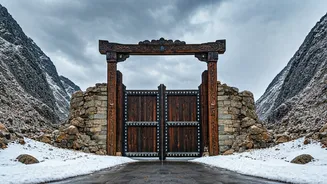Dham Yatra Closes
The Char Dham Yatra, a significant pilgrimage circuit in the Indian state of Uttarakhand, has officially come to a halt for the winter. The sacred shrines
of Gangotri, Kedarnath, and Yamunotri have been closed to the public. This seasonal closure is a regular occurrence, dictated by the harsh weather conditions that prevail in the high-altitude regions during the winter months. These temples are dedicated to Hindu deities, attracting scores of devotees from all over India and abroad. The closure signifies a time for the deities to 'rest' and allows the local communities to prepare for the severe winter season. The physical temples are not accessible until the reopening, which usually happens in the spring, marking the commencement of the next yatra season.
Temples Shut Down
The closure process involved elaborate rituals and ceremonies before the portals of the temples were shut. In Gangotri, the temple doors were sealed after the main deity was carried in a palanquin to the village of Mukhwa, which is the winter home for the goddess. At Kedarnath, the idol of Lord Shiva was moved to the Ukhimath Omkareshwar temple, where winter worship takes place. Yamunotri also underwent a similar process, with the idol of the goddess relocated to Kharsali, its winter residence. The closing of the temples is not merely a physical act but is deeply rooted in religious beliefs and the practicalities of surviving in the Himalayan winter. This ensures the safety of the temples and the idols while also allowing the local population to concentrate on winter preparations, including stocking essential supplies and taking care of livestock.
Impact on Pilgrims
The closure of the Char Dham temples has a significant impact on pilgrims who had planned to visit during the winter. With the temples inaccessible, devotees need to adjust their travel plans and postpone their pilgrimage until the reopening in the spring. During the active season, the yatra attracts a large number of visitors, contributing to the local economy through tourism and related services. Many pilgrims seek spiritual solace and perform rituals at these sacred sites. The annual closure creates a sense of anticipation and marks a period of introspection for those who have completed the yatra. Pilgrims often return to their homes, carrying the blessings of the deities and the memories of their journey, eagerly awaiting the next opportunity to visit these revered sites. The seasonal closing of the Char Dham is a cultural tradition observed annually.
Winter Preparations Begin
The closing of the temples marks the commencement of extensive winter preparations in the region. The local communities gear up for the harsh weather conditions, ensuring the availability of essential supplies. This includes stocking up on food, fuel, and other necessities. The primary focus is on ensuring the well-being of the residents who live in the high-altitude areas. This involves preparing for heavy snowfall, extreme cold temperatures, and potential disruptions in transportation and communication. The closure also allows for necessary maintenance and repairs to the temple structures and infrastructure. The local economy adapts to the seasonal changes, with many businesses catering to the needs of the residents. Overall, the winter closure of Char Dham triggers a period of focused preparation, ensuring that life continues smoothly in these remote Himalayan areas.











